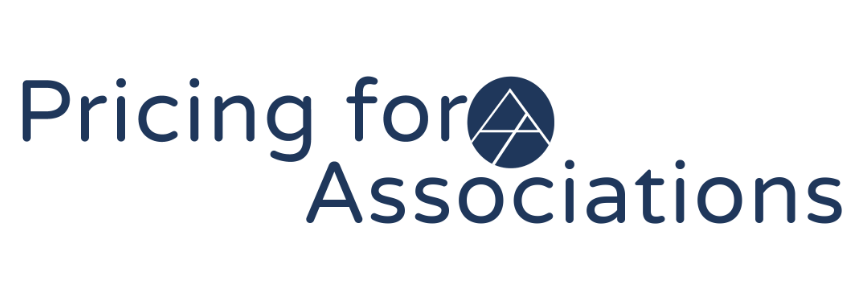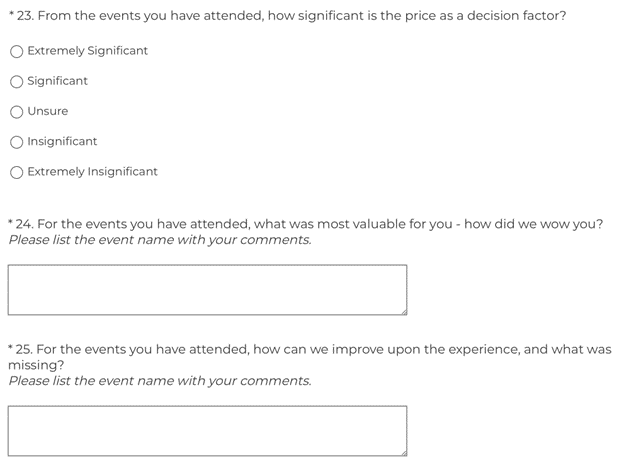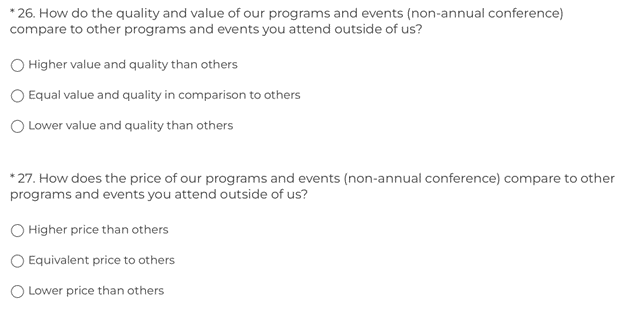Surveying for Product Value: A Comprehensive Guide
The following is an excerpt from our book, Pricing for Associations, available now on Amazon.
Launching a new product or updating a current product within your association demands precision and a profound understanding of your members' needs and preferences. Surveying becomes a pivotal tool in this journey, providing you with actionable insights and enabling you to fine-tune your offerings. Here's a comprehensive guide on how to conduct effective surveys for product value.
Methodology
When surveying for new or current product value, consider the following methodology:
Define Objectives: Clearly define the objectives of your survey, including the specific products or aspects you want to assess and the insights you hope to gain.
Select Survey Tools: Choose the appropriate survey tools based on your objectives and audience preferences. Options include online survey platforms, email surveys, and in-person interviews.
Design Survey Questions: Develop clear, concise, and relevant survey questions tailored to each product category, ensuring they align with your objectives.
Determine Sampling Method: Decide on the sampling method, whether it's targeting all users, a random sample, or specific user segments.
Collect Demographic Information: Include questions about participants' demographics, such as name, email, organization, current membership status, years in the industry, and organization size by revenue or employee count.
Distribute Survey: Distribute the survey to your target audience via email, social media, website announcements, or other channels.
Analyze Results: Analyze survey responses to identify trends, patterns, and areas for improvement.
Take Action: Use survey insights to inform product enhancements, marketing strategies, and organizational decisions.
When to Survey: Timing is Key
Surveys should be strategically timed to capture your audience's attention and curiosity. Consider launching surveys during the following stages:
Conceptualization Phase: Before the product is fully developed, gauge initial interest and expectations.
Beta Testing: During the beta testing phase, gather feedback on the actual user experience.
Post-Launch Assessment: After the product has been in use for some time, assess its impact and identify areas for improvement.
Pre-Survey Preparation: Setting the Stage for Success
Before participants delve into the survey, ensure they have a clear understanding of the product. Provide access to a video or demo, allowing them to visualize the offering. This preliminary exposure enhances the quality of responses, as participants can provide feedback based on a concrete understanding.
Survey Template: Crafting Comprehensive Questions
When creating a survey for a product, structure it to gather both quantitative and qualitative data. Here's a list of example questions to guide you, along with a visual template to see how we structure our own surveys for clients:
Personal Information:
Name
Email
May we follow up?
Organization Name
Title
Current Member (Yes/No/No, but have been in the past three years)
Demographic Information:
Length of time in the industry
Size of organization (by revenue or employees)
Length of membership with the organization
Product-Specific Questions:
Initial Thoughts:
What are your initial impressions of the product?
What are your top and bottom features, and why?
Problem-Solving Capability:
How does this product address a specific need or challenge you face?
How much time does this product save you?
Areas for Improvement:
Are there aspects of the product that you feel could be enhanced or clarified?
What is missing from this product?
Value Perception:
Does the value align with the price, is the value higher than the price, or is the price higher than the value?
Product Category-Specific Questions:
For Membership:
How satisfied are you with your association membership overall?
What features or benefits do you find most valuable in your membership?
How likely are you to renew your membership?
What improvements would you like to see in your association membership?
What specific benefits would make a membership offering indispensable for you?
In terms of networking, what features or events would you like to see exclusive to members?
How important is access to premium content in determining the value of a membership?
For Educational Offerings:
How satisfied are you with the educational offerings provided by the association?
Have the educational programs helped you advance in your career or professional development?
What topics or areas would you like to see covered in future educational programs?
How would you rate the quality of the instructors or presenters?
Which learning formats do you find most effective? (Webinars, workshops, self-paced courses)
Are there specific topics or areas of expertise that you feel are lacking in current educational offerings?
How crucial is industry certification or recognition in your decision to participate in educational programs?
For Certification:
How valuable do you consider the association's certification program to be in your industry?
How has obtaining the certification impacted your career or professional standing?
What improvements would you suggest for the certification process?
Would you recommend the certification program to others in your industry?
What certifications are currently recognized as valuable in your industry?
Are there gaps in existing certifications that we could fill?
How does the credibility of the certifying body influence your decision to pursue a certification?
For Events:
How satisfied are you with the association's events, conferences, or seminars?
What aspects of the events do you find most valuable or enjoyable?
Are there any specific types of sessions or topics you would like to see included in future events?
How likely are you to attend future association events?
What types of events do you find most valuable for professional development?
How crucial is the inclusion of expert panels or keynote speakers in your decision to attend an event?
Are there specific networking formats you prefer at events? (Roundtables, mixers, structured networking)
For a Sponsorship Opportunity:
How valuable do you find the sponsorship opportunities offered by the association?
Have sponsorship opportunities helped you achieve your marketing or business goals?
What improvements or additional benefits would you like to see in sponsorship packages?
How likely are you to sponsor future association events or programs?
What visibility options are most attractive to your organization in a sponsorship opportunity?
How does alignment with your organization's values and mission impact your interest in sponsorship?
Are there specific industries or sectors you would prefer to connect with through sponsorships?
The following is a visual example from one of our value survey templates:
Best Practices for Survey Implementation:
Keep it Concise: Respect participants' time by keeping the survey concise and focused on key insights.
Anonymous Option: Provide the option for participants to remain anonymous, encouraging honest feedback.
Incentives: Consider offering incentives for survey participation, fostering higher engagement.
Open-Ended Questions: Include open-ended questions to capture nuanced opinions and suggestions.
Analyzing Survey Data: Turning Insights into Action
Once the survey is complete, analyze the data systematically. Look for patterns, recurring suggestions, and areas of consensus or contention. Use these insights to refine the product, addressing concerns, and aligning it more closely with your members' expectations.






















